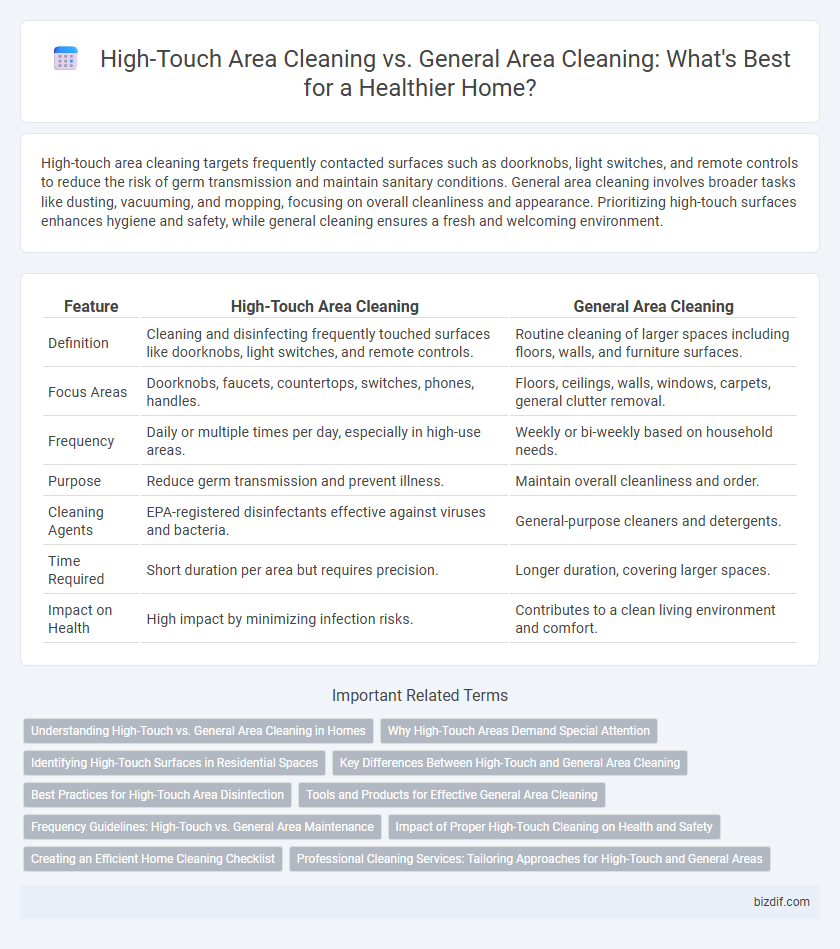High-touch area cleaning targets frequently contacted surfaces such as doorknobs, light switches, and remote controls to reduce the risk of germ transmission and maintain sanitary conditions. General area cleaning involves broader tasks like dusting, vacuuming, and mopping, focusing on overall cleanliness and appearance. Prioritizing high-touch surfaces enhances hygiene and safety, while general cleaning ensures a fresh and welcoming environment.
Table of Comparison
| Feature | High-Touch Area Cleaning | General Area Cleaning |
|---|---|---|
| Definition | Cleaning and disinfecting frequently touched surfaces like doorknobs, light switches, and remote controls. | Routine cleaning of larger spaces including floors, walls, and furniture surfaces. |
| Focus Areas | Doorknobs, faucets, countertops, switches, phones, handles. | Floors, ceilings, walls, windows, carpets, general clutter removal. |
| Frequency | Daily or multiple times per day, especially in high-use areas. | Weekly or bi-weekly based on household needs. |
| Purpose | Reduce germ transmission and prevent illness. | Maintain overall cleanliness and order. |
| Cleaning Agents | EPA-registered disinfectants effective against viruses and bacteria. | General-purpose cleaners and detergents. |
| Time Required | Short duration per area but requires precision. | Longer duration, covering larger spaces. |
| Impact on Health | High impact by minimizing infection risks. | Contributes to a clean living environment and comfort. |
Understanding High-Touch vs. General Area Cleaning in Homes
High-touch area cleaning targets surfaces frequently contacted, such as doorknobs, light switches, and remote controls, to minimize the spread of germs and bacteria. General area cleaning involves routine tasks like vacuuming floors, dusting furniture, and tidying spaces to maintain overall home cleanliness and aesthetics. Prioritizing high-touch surfaces ensures enhanced hygiene, especially in preventing illness, while general cleaning supports a comfortable and organized living environment.
Why High-Touch Areas Demand Special Attention
High-touch areas such as doorknobs, light switches, and remote controls harbor significantly higher concentrations of bacteria and viruses compared to general surfaces, making them critical points for contamination. Regularly disinfecting these spots reduces the risk of illness transmission and maintains a healthier living environment. Unlike general area cleaning, which targets visible dirt and dust, high-touch area cleaning emphasizes thorough sanitization to protect against pathogens.
Identifying High-Touch Surfaces in Residential Spaces
High-touch surfaces in residential spaces include doorknobs, light switches, faucet handles, remote controls, and countertops, which require more frequent and thorough cleaning to prevent cross-contamination. General area cleaning targets less frequently touched surfaces like walls, floors, and baseboards, focusing on overall cleanliness rather than disinfecting. Prioritizing high-touch area cleaning reduces the spread of germs and viruses in homes, especially in kitchens and bathrooms where contamination risk is higher.
Key Differences Between High-Touch and General Area Cleaning
High-touch area cleaning targets surfaces frequently contacted, such as doorknobs, light switches, and remote controls, to minimize germ transmission and reduce infection risk. General area cleaning involves broader tasks like vacuuming floors, dusting furniture, and cleaning windows to maintain overall cleanliness and aesthetic appeal. The key differences lie in frequency, focus, and purpose: high-touch cleaning requires more frequent, targeted disinfection, while general cleaning addresses overall surface maintenance.
Best Practices for High-Touch Area Disinfection
High-touch area cleaning targets surfaces frequently contacted, such as doorknobs, light switches, and remote controls, requiring disinfectants with proven efficacy against viruses and bacteria. Best practices emphasize using EPA-approved disinfectants, allowing appropriate dwell time, and employing microfiber cloths to reduce cross-contamination risks. Regular cleaning schedules combined with attention to material compatibility enhance the effectiveness of high-touch area disinfection in maintaining a healthy home environment.
Tools and Products for Effective General Area Cleaning
Effective general area cleaning relies on versatile tools such as microfiber mops, vacuum cleaners with HEPA filters, and multi-surface cleaning sprays designed to safely remove dirt and dust from floors, walls, and furniture. Unlike high-touch area cleaning, which requires disinfectants with antiviral properties, general cleaning products prioritize routine maintenance and surface protection without harsh chemicals. Using appropriate tools ensures thorough removal of everyday grime while preserving the integrity of various household surfaces.
Frequency Guidelines: High-Touch vs. General Area Maintenance
High-touch areas such as doorknobs, light switches, and countertops require cleaning multiple times daily to minimize the spread of germs and maintain hygiene. General area cleaning, including floors and walls, typically follows a weekly or biweekly schedule to ensure overall cleanliness without excessive resource use. Adhering to these frequency guidelines helps optimize cleaning efficiency and maintain a healthy home environment.
Impact of Proper High-Touch Cleaning on Health and Safety
Proper high-touch area cleaning significantly reduces the spread of harmful pathogens on frequently contacted surfaces such as doorknobs, light switches, and countertops, lowering the risk of infections and illnesses. Unlike general area cleaning, which addresses overall cleanliness, targeted disinfection of high-touch points interrupts transmission pathways of bacteria and viruses, enhancing health safety in homes. Effective high-touch cleaning protocols contribute to maintaining a hygienic environment, critical for preventing disease outbreaks and protecting vulnerable individuals.
Creating an Efficient Home Cleaning Checklist
High-touch area cleaning targets frequently contacted surfaces like doorknobs, light switches, and remote controls, using disinfectants to reduce germs and prevent illness. General area cleaning involves vacuuming, dusting, and mopping broader spaces such as floors, countertops, and furniture for overall tidiness and maintenance. An efficient home cleaning checklist prioritizes high-touch areas for daily attention while scheduling general cleaning tasks weekly or biweekly to balance hygiene with time management.
Professional Cleaning Services: Tailoring Approaches for High-Touch and General Areas
Professional cleaning services differentiate between high-touch area cleaning and general area cleaning by prioritizing disinfecting surfaces like doorknobs, light switches, and countertops in high-touch zones to reduce germ transmission. General area cleaning focuses on routine dusting, vacuuming, and mopping of floors and less frequently touched surfaces to maintain overall cleanliness. Tailoring these approaches ensures effective hygiene management and optimizes resource allocation in residential and commercial spaces.
High-touch area cleaning vs General area cleaning Infographic

 bizdif.com
bizdif.com